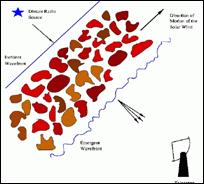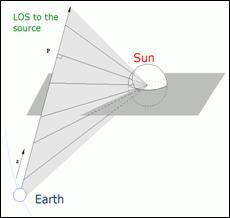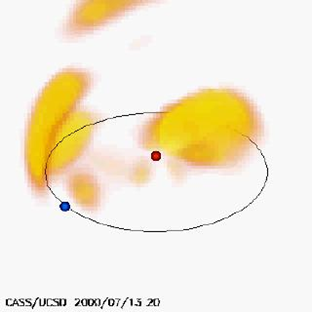Interplanetary Scintillation (IPS)

Figure 1
Interplanetary Scintillation (IPS) is essentially the radio analogue of optical twinkling of stars due to the Earth's atmosphere. The plane wave-front from a distant radio source picks up phase corrugations as it traverses the density fluctuations in the solar wind as illustrated in the schematic below. These phase corrugations develop into an interference pattern by the time they reach an Earth-based observer. The motion of the solar wind sweeps this interference pattern past the observing telescope giving rise to intensity fluctuations which are referred to as interplanetary scintillations as illustrated in Figure 1. In the weak scattering regime, the power spectrum of the intensity fluctuations can be modeled in terms of the velocity, the strength of scattering, and a few other physical properties of the solar wind such as density, through which the radiation has traveled.

Figure 2
The geometry for IPS observations is illustrated in Figure 2. IPS observables are line-of-sight (LOS) integrals and hence they are sensitive to the properties of the solar wind all along the LOS. The propagation time from the Sun to a point on the LOS can vary by up to a few days, and the LOS projected back on the Sun spans around 100 degrees in length. An IPS observation is thus sensitive to the solar wind arising over an extended window in time and from an extended region on the solar surface.
In a Sun-centered frame, the Earth rotates around the Sun every 27 days. The rotation of the Sun and the outward motion of the solar wind allow an Earth-based telescope to obtain many different perspective views of the long-lived stable features in the solar wind. A large number of lines-of-sight to observed IPS sources, filling the entire inner heliosphere, can therefore be obtained and used for tomographic reconstruction of the distribution of the solar wind in the inner heliosphere as has been successfully done at various radio observatories. An example from the UCSD analysis of data from the STELab IPS array is shown in Figure 3 for the storm of July 13, 2000, illustrating the density structures emanating from the Sun towards orbiting Earth (Jackson and Hick, 2005).

Figure 3
The MWA's powerful multi-beaming ability will allow it to observe 16 sources simultaneously in its wide field-of-view. This will increase the density of sampling of the heliosphere by more than an order of magnitude, addressing one of the most constraining bottleneck of existing observations and will allow it to better deal with the time evolution of the solar wind over the 27 day period. Furthermore, the higher sensitivity of the MWA will allow it access to a larger number of sources in the sky.
Close collaboration between the MWA and other groups that gather and analyze IPS measurements from various observatories an analysis centers is anticipated. This includes STELab, UCSD, Ooty, EISCAT, and MEXART. A common format suitable for processing data from all these observatories, including the MWA, is planned. It is recognized that the availability of data from the southern hemisphere at the longitude of the MWA is expected to greatly complement and augment the measurements from the other observatories.
References
Jackson, B. V. and P. P. Hick, "Three-Dimensional Tomography of Interplanetary Disturbances", in: D.E. Gary and C.U. Keller (eds.), "Solar and Space Weather Radiophysics, Current Status and Future Developments", Chapter 17, Astrophysics and Space Science Library 314, 355-386, 2005.

